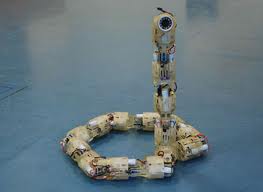Snakebot – a third generation model being developed for Mars exploration
Saturday, November 26th, 2011 6:48:06 by M. Omer Iqbal bhatti
Snakebot – a third generation model being developed for Mars exploration
Snakes are unique creatures in that their bodies allow them to get into the cracks and crevices of the world that most other creatures cannot. Lacking rigid skeletons and extremities, snakes can contort their bodies in order to get into tiny holes, wrap
around tree branches and slither over otherwise unmanageable rocks. These serpentine qualities are the inspiration for a new type of robotic, interplanetary probe, called a snakebot, being developed by engineers at NASA’s Ames Research Centre.
Snakebots are unlike any robotic probe ever to be used for space missions. In order for a robot to mimic the movements of a biological snake, some special design features have to be used. NASA’s snakebots are a model of the polybot developed by Mark Yim
of Xerox Palo Alto Research Centre. Polybots are robots that are able to change their shape in order to perform a variety of tasks. Snakebots will slither and dig underneath the soil for geological surveying, or coil up to carry tools for construction in space.
Since 1964, NASA has sent 10 robotic explorers to fly by; orbit or rove around Mars, but snakebots will give scientists an unprecedented look at the Martian landscape. Snakebots, which could be ready by 2005, will be able to dig into the loose soil of Mars
and burrow down to depths that other robotic probes can’t get to. They can slither into the cracks of the planet’s surface. "A snakebot could navigate over rough, steep terrain where a wheeled robotic rover would likely get stuck or topple," lead snakebot
engineer Gary Haith says.
Snakebots are expected to be more durable and cheaper than any probe that has ever been sent to investigate a planet.
Snakebots will be able to limit the weight of the spacecraft ferrying them to space. The snake-like design allows them to perform many tasks without a lot of extra equipment. "One of the many advantages of the snake-based design is that the robot is field-repairable,"
NASA engineer Gary Haith says. "We can include a bunch of identical spare modules with the snake on a space mission, and then we can fix the snakebot much easier than a regular robot that needs specific parts."
Unlike past robotic probes, snakebot will be very cheap. In contrast to the $135-million Mars Odyssey that was launched on April 7, 2001, snakebots will probably cost only a few hundred dollars each. In fact, the cost of the snakebot is so low that one researcher
says there is a possibility of developing a toy version.
Short URL: https://www.newspakistan.pk/?p=4797

















